Each journey is an opportunity to discover magical corners of the world, but some spots on the map leave visitors wide-eyed with amazement. One such place is Meteora—one of the greatest wonders hidden within mainland Greece.
Located in central Greece, near the towns of Kalambaka and Kastraki, Meteora is considered by many to be one of the most beautiful places in all of Greece. It’s hard to disagree, as the monastic complexes perched atop stone peaks rising from the Thessalian Plain create a breathtaking sight. Adding to this is the picturesque mountain range in the background, creating an unforgettable landscape. The Meteora massif is extraordinary not only for its aesthetic appeal but also for its historical and cultural significance. Due to its unique character and perfect integration with the surrounding environment, the Meteora monastery complex was inscribed on the UNESCO World Heritage List in 1998.
GOOD TO KNOW: In Greek, “Metéoros” means “suspended in the air” or “lofty.” One glance at the monasteries perched on rocky pillars makes it clear why this place was given such a name.
How was Meteora formed?
According to the theory of German geologist Philippson, who began studying the area in the late 19th century, the site of today’s Meteora massif was submerged under the sea for millions of years.
It was the accumulation of stones, mud, and other sediments at the sea’s bottom that began forming what are known as delta cones. Later geological movements caused the sea waters to flow into what is now the Aegean Sea, and from beneath the water’s surface emerged towers of sandstone and conglomerate. However, the rocks needed millions more years to take their current shape, as wind and rain erosion gradually sculpted them.
The History of the Greek Monasteries
The first monks arrived in the natural recesses of the rocks around the 11th century. The difficult-to-access caves and peaks provided an ideal refuge for hermits seeking spiritual isolation and protection from religious persecution by the Turks. The first structures atop these rocks were built around the 14th century. It remains uncertain exactly how the monasteries were constructed in such an inaccessible location. However, it appears that they were built using primitive scaffolding made from wooden pegs driven into the stone crevices. Today, it’s hard to believe that the first monks climbed the rocks, carrying the materials needed for construction on their backs. Thankfully, the strategy quickly evolved, and materials for subsequent buildings were hoisted up using ropes.
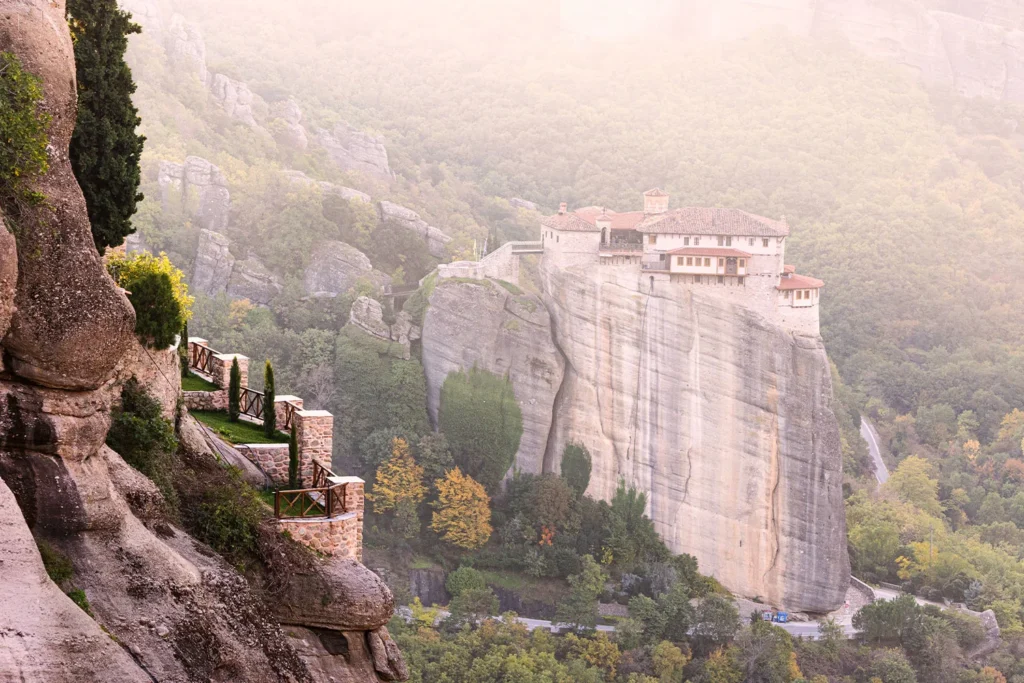
The monasteries soon became significant centers of worship. So significant, in fact, that 24 monasteries were eventually built on the rocks! Treasures were collected within their walls, and the monasteries drew income from donations and nearby land estates. Their period of prosperity began to decline in the 17th century for several reasons. Spiritual development was overshadowed by conflicts between abbots, and poorly preserved buildings began to deteriorate. Further damage was inflicted during World War II. How many of these remarkable monasteries have survived to this day?
Monasteries suspended in the clouds
Out of the original 24 monasteries, only 13 have survived to this day, and some of them are unfortunately in ruins. Currently, only six monasteries still maintain monastic life, and they are open for visitors. Among these, there are four male and two female monasteries.
At first glance, the Greek Meteora monasteries seem extremely inaccessible, but that’s a deceptive impression. All of them are reachable. If you enjoy physical activity, you can climb to the peaks just as the first hermits did. However, most visitors opt to reach the monasteries using the stone-carved stairways. The paths leading upward are somewhat steep, and since the interiors of the monasteries do not differ drastically from one another, many tourists visit just 2-3 monasteries instead of climbing to all available ones. Are you planning a trip to mainland Greece and unsure which monastery to visit? We’re here to help. Below is a brief guide to each of them.
The Monastery of the Transfiguration of Christ
The Monastery of the Transfiguration of Christ, also known as the Great Meteoron Monastery, is the oldest and largest of the structures perched atop the rocky peaks. It was built on the most impressive rock, known as the Broad Rock, which stands 613 meters above sea level. The Great Meteoron was founded shortly before the mid-14th century by Saint Athanasius, who is credited with organizing the entire monastic community. After Athanasius’ death, King Ioasaph of Thessaly, who had become a monk, took over the monastery and expanded the modest original church into the magnificent structure seen today.
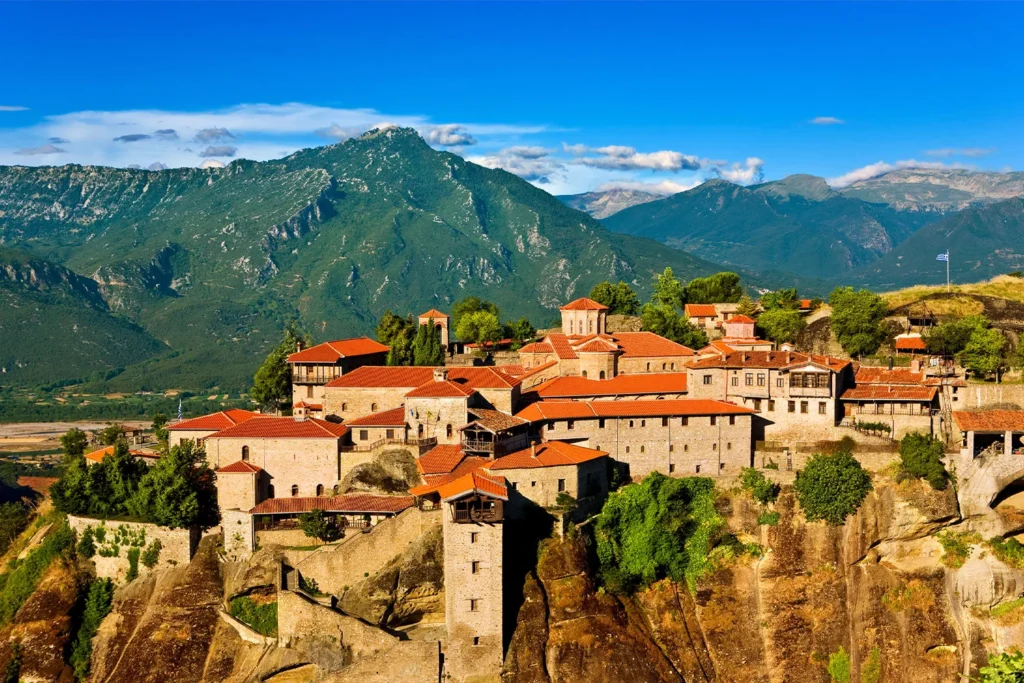
The Great Meteoron is one of the most frequently visited monasteries on the Thessalian Plain. Why? It not only represents the characteristic architecture of the Meteora monasteries but also serves as the main museum of the entire monastic complex. Inside the sanctuary, visitors can admire well-preserved frescoes of the Macedonian school, icons, books, and codices. Nearby is the old tower with a lift used for hoisting materials. You can also explore the old kitchen, refectory, and five small chapels. However, the most striking feature is the eerie ossuary, which holds the skulls and relics of the monks who once lived in the monastery.
Monastic Charms Not for Everyone
You won’t want to leave the Monastery of the Transfiguration without a stop at its viewing terrace. From the large plaza next to the monastery, you’re treated to a breathtaking view, often described as one of the best in the area. However, not everyone chooses to visit. The spectacular panoramas offered by the Great Meteor and the popularity of the monastery make it the most commercial and crowded of the nearby peaks. For this reason, many visitors who prefer to avoid large crowds and touristy atmospheres opt to explore other, more intimate monasteries instead.
FUN FACT: There’s an unusual legend associated with the construction of the first monastery. According to the story, Saint Athanasius didn’t climb to the top of the rock like the local monks. Instead, he was said to have been lifted there on the wings of an eagle.
Varlaam Monastery
Located directly opposite the Monastery of the Transfiguration, the Varlaam Monastery dates back to 1500 and is the second largest monastery in Meteora. It takes its name from the hermit Varlaam, who first settled on the rock in the 14th century.
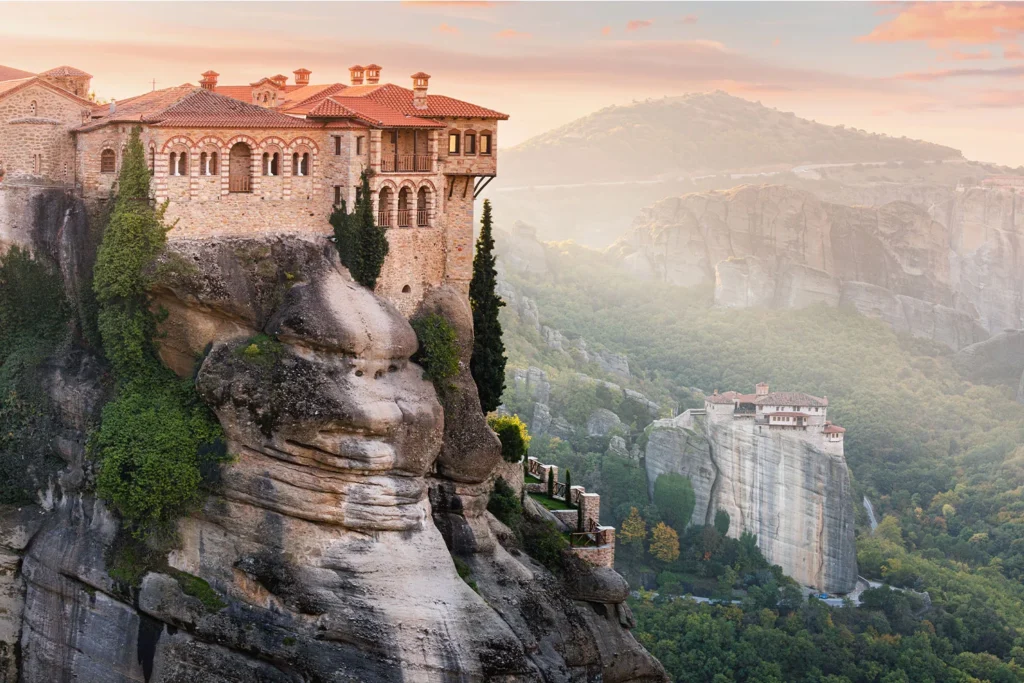
What can you see at this monastery? Like the Great Meteor, it features a crane that was used from its construction until the 1930s, and inside, you’ll find Byzantine frescoes and a former refectory that has been converted into a religious museum housing monastic relics. What sets this monastery apart is the Chapel of the Three Hierarchs, adorned with frescoes depicting scenes from the life of Jesus, considered one of the most magnificent parts of this complex.
The Monastery of Saint Stephen
Though the first monks settled here at the end of the 12th century, the structures admired by tourists today were built in the 15th century, and the monastery took its current form in 1798. Saint Stephen’s Monastery is one of two convents. Just inside the entrance, you’ll find the monastic cells, and on the eastern side of the courtyard, there are stables and other auxiliary rooms.
Inside, the monastery is another treasure trove of frescoes, this time by contemporary Greek painter Vlasis Tsotsonis. The monastery also boasts two chapels worthy of attention. The old 15th-century chapel of Saint Stephen was severely damaged during World War II and is now used only for religious purposes by the nuns. The 18th-century main chapel is dedicated to Saint Charalambos and holds special significance, as the nuns guard the relics of this Greek saint.
Stone Peak Within Reach
The Monastery of Saint Stephen is often regarded as the most beautiful in Meteora. However, it’s not just its aesthetic appeal that attracts so many visitors. This monastery provides easy access to Meteora’s peak without the need to climb the tiring steps required for most of the other monasteries. No climbing is necessary here, as the monastery is connected to the main road by a bridge spanning the chasm. This makes it accessible even for people with disabilities or families with small children, allowing them to fully experience Meteora while enjoying the stunning scenery of the vast Pinios River valley and the panoramic view of Kalambaka.
Roussanou Monastery
Roussanou Monastery, also known as the Monastery of Saint Barbara, is primarily dedicated to her memory. It’s one of the lower-lying monasteries in Meteora, making it more easily accessible without sacrificing charm. The entire building occupies the available space on the cliff, and its exterior blends with the sandstone rock. This creates the illusion from afar that the monastery is carved into the stone pillar itself, appearing as a natural extension of the rock.
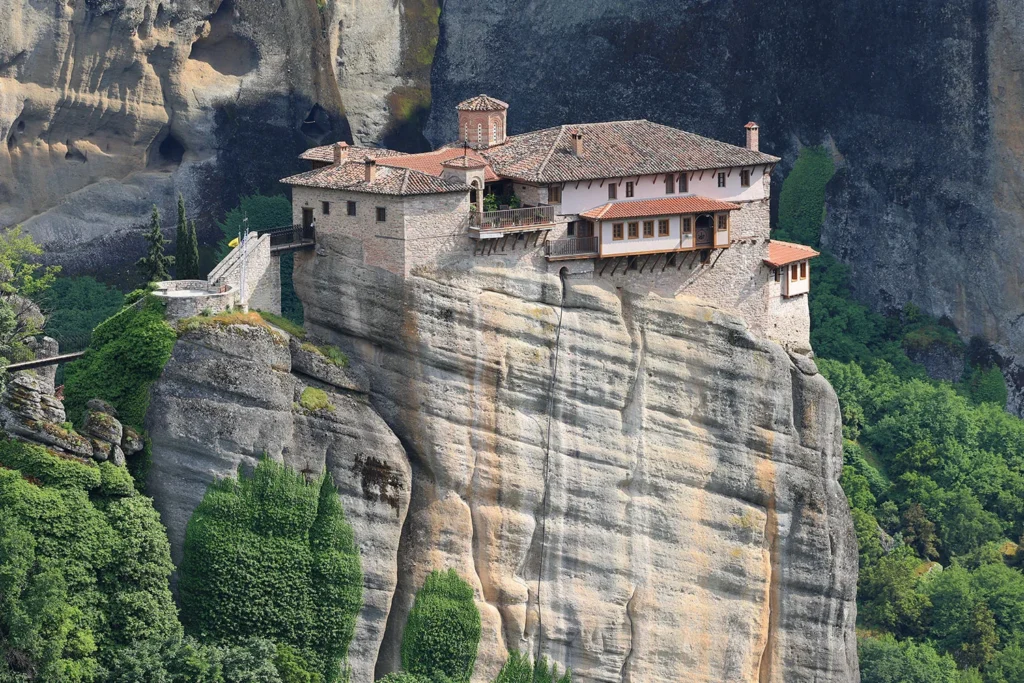
The rock has been inhabited since the early 14th century, but the monastery took its current form in the 16th century, thanks to brothers Ioasaph and Maximos from Ioannina. Though the monastery doesn’t house museums or saintly relics, its murals are sure to impress. The frescoes that adorn Roussanou’s walls date back to 1560, associated with the name Arsenios—not the artist but a monk who was the abbot at the time. The identity of the painter remains unknown, but he is considered one of the most talented artists of the Cretan School.
Holy Trinity Monastery
The Monastery of the Holy Trinity is one of the least-visited in Meteora. However, this shouldn’t deter anyone, as its low visitor numbers are not due to unattractive interiors or a less desirable location, but rather to the slightly more challenging access. The trek to this monastery isn’t overly difficult, and after a walk to the base of the cliff and a climb of 150 stone steps, you’ll be rewarded with an otherworldly view.
The monastery, dedicated to the Holy Trinity, was built in 1476. At one time, it was known for housing priceless icons and 124 manuscripts, which were transferred to the treasuries and libraries of other nearby monasteries after the German occupation during World War II. The frescoes in the monastery’s church were created by painter and priest Antonios and his brother Nikolaos in 1741, reflecting the Byzantine art style. If you choose to visit this monastery, be sure not to miss the chapel of Saint John the Baptist, carved into the rock, featuring stunning 17th-century frescoes.
Monastery of Saint Nicholas Anapausas
The Monastery of Saint Nicholas Anapausas is the closest monastery to the town of Kastraki and likely served as the first stop for villagers on their journey to the Meteora complex, hence the “Anapausas” or “resting” in its name. This is the smallest monastery in the area, but it stands out architecturally due to the limited space on the rock it occupies. The builders were forced to design a multi-story structure, and as a result, you won’t find the typical courtyard that plays a central role in most other monasteries.
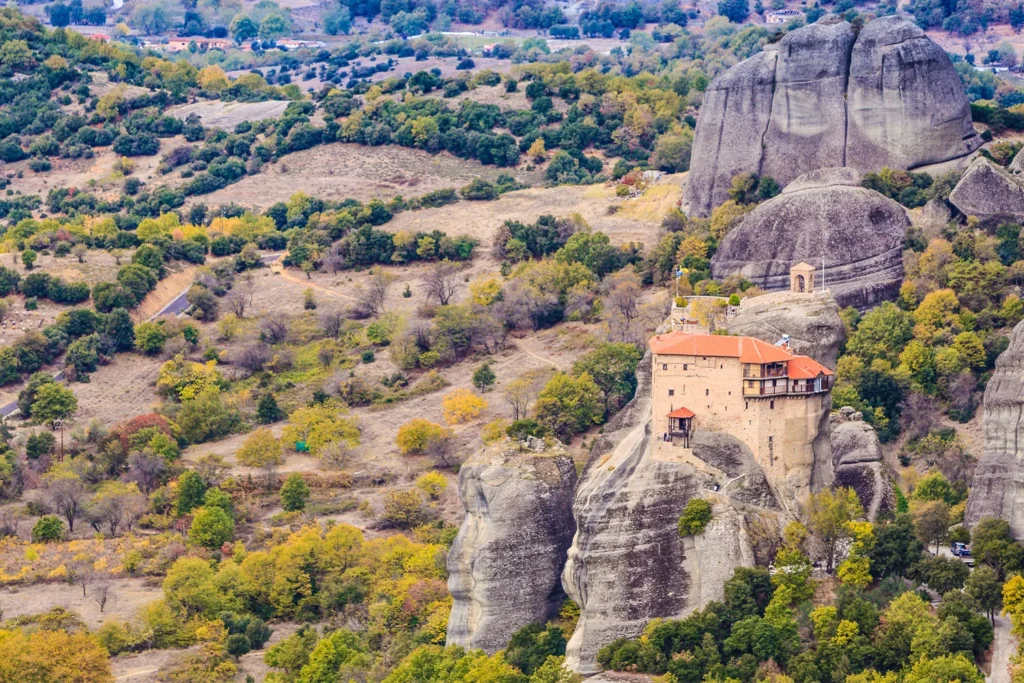
Founded in the late 14th century, the monastery’s main attraction is its small, single-aisled church with a dome. Its richly adorned frescoes, created in 1527, are the work of Cretan painter Theophanis Strelitzas, as confirmed by an inscription above the entrance to the main nave. Among the frescoes, you can find rare depictions such as Adam naming the animals, the Assumption of Saint Nicholas, and the four evangelists.
Meteora on the Big Screen
Film enthusiasts might recognize the stunning scenery of Meteora from one of the iconic cinematic productions. The picturesque location, specifically the Holy Trinity Monastery, served as a backdrop for the 1981 James Bond film “For Your Eyes Only”. Interestingly, the film crew received permission from the Greek Ministry of Culture to shoot on location, but the resident monks were not pleased. Due to this conflict, the producers were forced to use only exterior shots of the monastery, and the interior scenes were filmed on a set built specifically for the movie.
The James Bond film was one of the first to bring global fame and popularity to Meteora, attracting thousands of tourists. However, it wasn’t the last time these monasteries in the sky inspired filmmakers. In the popular TV series “Game of Thrones”, Meteora served as the model for the Eyrie, the ancestral seat of House Arryn. Although the scenes weren’t shot at the foot of the Meteora cliffs, the landscape was digitally recreated based on this stunning Greek location.
Other Attractions of the Thessalian Plain
You can embark on a one- or two-day organized trip to the Meteora from Athens or Thessaloniki (you can book such a trip through platforms like GetYourGuide). However, some travelers, enchanted by the Meteora’s majestic landscapes, opt for a longer stay in the area. If you, too, decide to explore the secrets of Thessaly more thoroughly, the best option is to stay in Kalambaka, known for its extraordinary Byzantine Church of the Virgin Mary, or in the nearby town of Kastraki.
While the main attraction of Meteora is, without a doubt, the cluster of Orthodox monasteries, there are other hidden gems among the rocky heights worth discovering. As you wander through the green landscapes of the plain, be sure to look out for these fascinating sites:
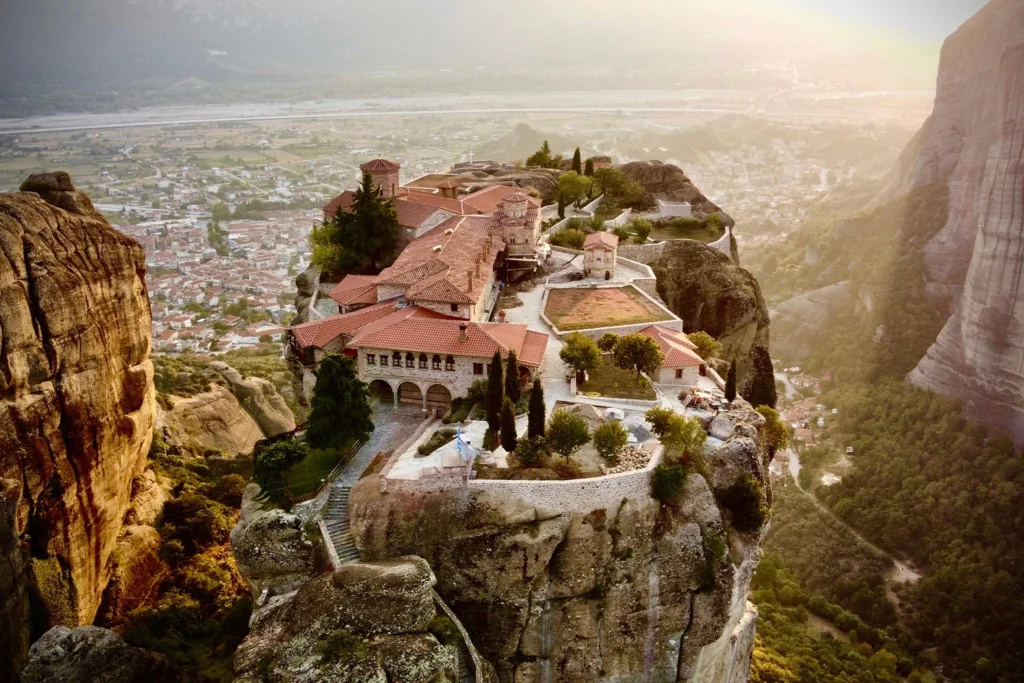
- Adhrakhti – this impressive stone pillar is considered the geological heart of the entire Meteora massif.
- Doupiani Rocks – The site where the first church of the area, Anaghia Doupani, was built. Though the church is no longer there, it remains a popular destination for beginner climbers.
- Theopetra Cave – Just 7 km from Kalambaka, this cave was inhabited by humans for over 130,000 years. Visitors can explore the cave easily thanks to a system of walkways installed for public access. Officially opened in 2009, the cave also yielded a significant discovery in 2010: a wall built over 23,000 years ago, making it the oldest known man-made structure.
What you should know before visiting Meteora?
If you’re planning a trip to the Meteora’s towering rock formations, it’s essential to be well-prepared. There are no shops or restaurants within the monastery grounds, so it’s a good idea to bring some snacks and, most importantly, water. The climbs to the monastery peaks can be challenging, especially in Greece’s scorching summer heat. It’s also important to remember that the suspended monasteries are not just tourist attractions but places of religious worship. As such, appropriate attire is required for visiting. Women are only allowed to enter if wearing long skirts (or loose pants) and covering their shoulders, while men must wear long trousers.
Before setting out to explore the Meteora, be sure to check the opening hours of the monasteries. They vary considerably depending on the monastery and the time of year. During the summer season, one monastery is closed each day, while outside the season, some buildings are closed up to three days a week. For example, the Varlaam Monastery is closed every Friday, the Holy Trinity Monastery is closed on Thursdays, while the Monastery of Saint Nicholas Anapausas is the only one open every day.
Practical information
- It is worth booking tickets for Meteora tours in advance. There are many tours available with experienced guides who will show you the most interesting spots, answer questions, and share fascinating facts about the areas being visited.
- Buy a guided tour on GetYourGuide